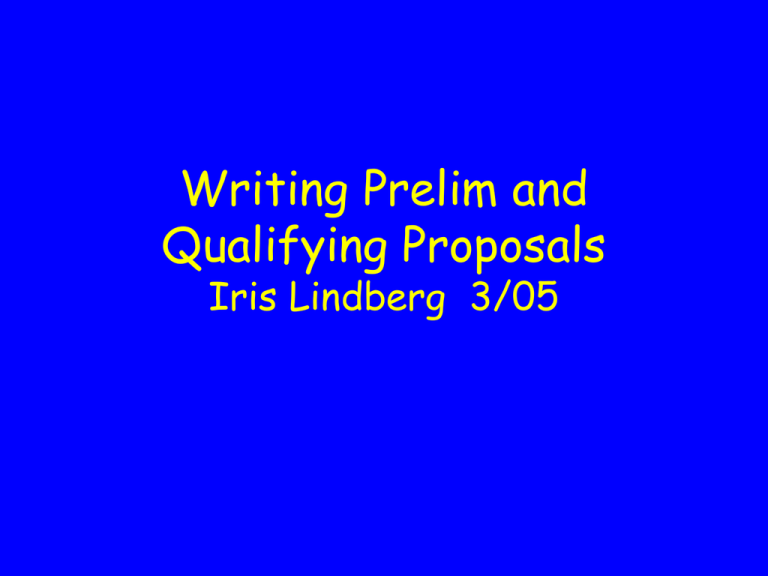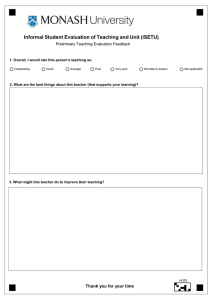Writing Prelim and Qualifying Proposals Iris Lindberg 3/05
advertisement

Writing Prelim and Qualifying Proposals Iris Lindberg 3/05 Timing • Qualifying- collect references from the time you enter the lab (ie for a semester) • Qualifying- you need experimental data before you can propose work, so do not stop lab work until 1-2 weeks before proposal is due • Preliminary- be collecting “interesting references” during the same time period • Preliminary- discuss possible topics with committee at Qualifying Exam • Take off only 2 weeks full-time to write Preliminary proposal (or longer but then only parttime) Topics of Each Exam • Qualifying – Shows mastery of your field – Outlines the next few years of experiments • Preliminary – Topic must be out of your field – Shows you can think/design/present science independently Getting Ideas and Writing Experimental Design • Do not focus on technique but answering a definitive question • “What is missing from this picture?” Experimental DesignPlanning • A small, focused project is much better than a diffuse, multifaceted project- do not be overambitious! • Use 2-3 specific aims at most • Get advice from your committee on potential aims during planning stages • Committee approval is required for Prelim exam topic Experimental Design: What Constitutes a Good Experiment? • “Doability” is required but by itself is not enough- Timeliness and Significance • Unambiguously interpretable results • If result 1 is obtained, your hypothesis is upheld • If result 2 is obtained, then a new direction is indicated (but grant is not invalidated) • Stronger if different exptl approaches are used to confirm hypotheses Common Project Errors • Risky (pyramid approach) • Cataloging data (“Descriptive”) – Data must already fit into a hypothesis • No quantitation possible – How will different models/hypotheses be distinguished? – How will experimental bias be avoided? • Controls not explained adequately – How can results be arrived at artifactually? Page Requirements- Qualifying Proposal • • • • • Description (1/2 page) Specific Aims- 1 page Background and Significance- 3 pages Preliminary Studies- 3 pages Experimental Design – totals 25 pages including the above Page Requirements- Preliminary Proposal • Description (1/2 page) • Specific Aims- 1 page • Background and Significance- 1.5 pages • Preliminary Studies- 1-2 pages (no limits) • Experimental Design – totals 12.5 pages including the above The Description • This is a very important part of the proposals! Do not omit! • Introduce the subject, briefly explain what has been done and what gaps remain • Describe each of your aims succinctly, summarizing what you will learn • Put the project into a clinical perspective • Polish: remove extra words, make it elegant! A. Specific Aims • A one page summary of the proposal • Specific aims test specific predictions based on hypotheses • Provides rationale and brief summary of work, and the expected impact on field • Refine and revise this page multiple times! A very important part of the proposal (second only to abstract) Specific Aims can contain questions Or not.. B. Background and Significance • Comprehensive and clear background for the scientific reader who is not in the field • In-depth and critical knowledge of the literature demonstrated • Constantly point out “holes” or discrepancies that the present grant will address • Persuasive rhetoric: the reader must agree that the studies are necessary and important • Clinical relevance can go here as well as in significance section C. Preliminary Studies • You can cite supporting data from other labs here • You can present the data you think you would need in order to get your grant funded (this is unusual) • Because this is a hypothetical exercise, this section is not strictly necessary • In a real grant you would NEVER make anything up here! C. Preliminary Studies • All figures should be formatted nicely and located on same page as discussion. Use a conclusion for each title! • Number all figures for easy reference later D. Experimental DesignSections • • • • Rationale The experiments themselves Results and interpretation Potential pitfalls and alternative approaches • Summary of aim goals D. Experimental DesignRationale • Ties into the background section • Provides brief explanation for the experiments which follow The Rationale Begins the Experimental Design Section (part 1) D. Experimental Design, part 1 • Why did you choose the approach that you did? – Convince us that it is the best approach of all that are currently available. Cite the success of other investigators -with specific references. Experimental Design, part 2 • Lay out broad scope of experiments • Reserve technical details for another section at end • Do not be exhaustive- many experiments are POSSIBLE but will not add to the results! Experimental Design Part 3: “Anticipated Results and Interpretation ” • Use “anticipated results section” to convince us that you will move science forward -no matter how experiments come out! • Most common failing of grants is to omit the interpretation section – Make it obvious what you will learn from each set of experiments and how this moves the field forward Results and Interpretation Section Use persuasive words like : “will provide, will learn, confirm/refute, understand” etc… ie you will move the field forward! Experimental Design Part 4Potential Problems (or pitfalls) and Alternative Approaches • Use “pitfalls section” to anticipate possible problems- then try to persuade that they are not serious because you have alternative approaches (or, because others have data showing this) Potential Problems and Alternative Solutions Identify the problems before your reviewers do- then say why you don’t believe they will be obstacles, but if they are, what you will do Common Sense Items • Step back and look at your reasoning. Would you buy it from someone else? • Accept criticism from your colleagues even if you think it is wrong: it means you did not get your point across • Don’t perfect the beginning at the expense of the end- work on the last aim alone some days! • Polish, polish, and polish again. Remove excess words; construct clearer sentences; improve formatting • Give yourself enough time! References • You must include the titles of all references for NIH • Check to make sure that your references are accurate! • Any format ok Formatting The Package Is As Important as the Content • One cannot extract a great experiment from a hard-to-read page • Do not use “busy” fonts – Use Sans Serif such as Arial for Figures (10 point) and a Serif font (Times Roman or Palatino at 11 point) for all the rest of the text • Do not combine many fonts- bold, underline, italics and sizes on one page (and never underline! it is very difficult to read) • Separate all paragraphs with empty spacemake it look like a book (ie, easy to read) Make it Easy! • Your committee may read your grant over several weeks • Construct discrete sections which can be understood alone • They will not remember a rationale you presented only in the Background and Significance Lots of white space between small paragraphs! The Package Is As Important as the Content • Be extremely clear- few abbreviations, a simple layout, repeat/rephrase your necessary justifying statements throughout • No jargon!– we are NOT in this field • Perfect spelling and grammar show that you can pay attention to detail Consider putting experimental detail in a separate section at the end so that the flow of experiments is not interrupted Specific Methods Section (an NIH-acceptable 10 point font) Summaries • Use summaries throughout the grant to help the reviewer see what the grand goals of each aim are • Use a summary at the end of the grant to rephrase again how this proposal will move science forward (“tell them what you told them”) • Writing a grant is an act of rhetoric: you must persuade Use of Summaries Always Get Multiple Outside Opinions • You should have other people look at your proposals at all stages – Specific Aims can be discussed with your committee even prior to beginning to write! • Give your first draft to as people- both expert as well as non-expert- senior and non-senior, who will agree to read it (give them at least 2 weeks!) • Give the final draft to someone who is very good at finding typos and sentence errors (1-2 days) Self-Check • Did you provide persuasive language in every section? – Do not use highly self-promoting language • Did you make sure the last Aim is as well-written as the first? • Did you include the references and/or the actual papers that support your approach? • Did you polish sufficiently? (spellcheck, outside reviewers saw it) Please.. • The word “data” is PLURAL! • (ie data ARE or SHOW (never IS or SHOWS) Additional Resources • Your committee! is there for you to provide advice, technical tips, references etc • See references on Biochem 299 website – – – – University of Pittsburgh MIT Columbia Resource collection http://www.thescientist.com/yr1998/mar/prof_980302.h tml Any Questions? Good Luck!

